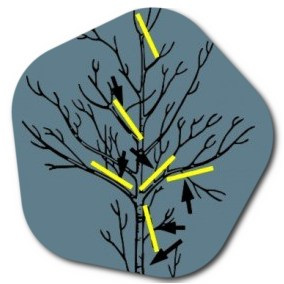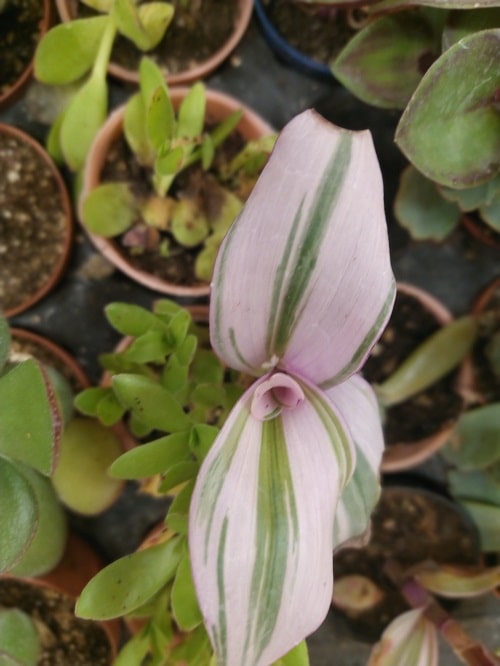When to prune ornamental plants? We cannot prune trees every season of the year as we wish. Especially leafy trees should be pruned after they shed their leaves. To give a date, the best time for pruning in our country is between November 15 and March 15. The timing of pruning is really important. Pruning potted ornamental plants: You can prune at any time of the year, but fall is the best time to prune after the summer of growth.
When to prune indoor plants? Pruning can be done in conjunction with repotting, but the best time is in the spring before new growth begins. Pruning ornamental plants at home is an essential gardening task that helps maintain the health, shape, and appearance of the plants. Proper pruning promotes growth, enhances flowering, and prevents disease. Strengthening and accelerating the development of ornamental plants, healthy development of plants. to provide the desired form, to provide the amount and quality of flowering and fruit Pruning is done to increase it.
Pruning; development of plants, strengthening, maintaining their healthy development, It is applied in ornamental plants in order to increase flowering, fruit quantity and quality. cutting, bending, bending, getting buds and shoots, adjusting the angle of the branches to the trunk such operations. Here’s a general guide on how to prune ornamental plants:
- Know Your Plants: Different plants have different pruning requirements. Research and understand the specific needs of each type of ornamental plant you have.
- Choose the Right Tools: Use sharp and clean pruning tools to avoid damaging the plants. Pruning shears, loppers, and pruning saws are common tools used for pruning.
- Timing: Prune at the appropriate time, which can vary depending on the plant species and whether it blooms on new or old wood. Some plants are pruned in early spring before new growth, while others are pruned after flowering.
- Remove Dead or Diseased Growth: Start by removing any dead, diseased, or damaged branches. This promotes plant health and prevents the spread of diseases.
- Shape and Size: Prune to shape the plant and control its size. Remove overgrown or crowded branches to improve air circulation and light penetration.
- Prune for Flowers: If your ornamental plant blooms on new wood, prune before new growth begins. For plants that bloom on old wood, prune after flowering to avoid cutting off potential flower buds.
- Angle and Clean Cuts: Make clean cuts at a slight angle just above a leaf node or a bud. Avoid leaving stubs, as they can invite diseases.
- Thinning: Thin out crowded branches to improve air circulation and light penetration. This prevents fungal issues and promotes overall plant health.
- Pinching: For bushy plants, use your fingers to pinch off the tips of new growth. This encourages branching and a fuller appearance.
- Vining Plants: Train and prune vining plants to support their growth. Remove excessive growth and encourage lateral shoots.
- Disinfect Tools: Between plants, disinfect your pruning tools with rubbing alcohol or a bleach solution to prevent the spread of diseases.
- Aftercare: After pruning, water the plants well to help them recover. Applying a balanced fertilizer can also support new growth.
- Step Back and Assess: Regularly step back and assess your work to make sure you’re achieving the desired shape and balance.
- Consult Resources: If you’re unsure about how to prune a specific plant, consult gardening books, online resources, or local gardening experts for guidance.

Remember that over-pruning can harm plants, so it’s better to start conservatively and gradually remove more if needed. Pruning is a skill that improves with practice, so don’t be afraid to learn as you go
Pruning ornamental plants for a healthy bloom
In general, pruning is very important in the growth, development and yield of plants. has an important place. Pruning practices are primarily related to plant physiology and ecology. should be appropriate. In general, the purposes of pruning in ornamental plants are as follows: We can sort:
- Creating and maintaining physiological balance in ornamental plants in a short time.
- Remove branches that may fall from the tree, causing injury or property damage. remove.
- Removing branches that block the view of the roads from the tree.
- Dried, diseased, broken by ecological and mechanical effects, damaging each other and diagonally overlapping each other, protruding from below, head drooping down, out of symmetry, destabilizing the tree, weak, narrow angle cut branches.
- In order to increase carbon assimilation (assimilation) in plants, the use of light to allow better penetration into the inner parts of the trees and to clean the leaf surfaces. increase.
- By arranging the number and distribution of the main branches on the trunk, to ensure that they form a strong, regular and balanced crown.
- To give the plants a beautiful appearance by giving different shapes.
- Maintain a shape given to plants.
- To increase the flower yield and quality of plants.
The pruning time of ornamental plants may vary according to the species. for pruning Generally, plants are in a dormant state and in the ability to develop under certain conditions. Pruning times should be determined by taking into account the pruning according to some species We can express the times as.
- The main pruning season for deciduous species is late winter. However, the growth in flowering species (ornamental cherry, ornamental apple, locust, redbud etc.) pruning during the flowering periods, ie in late spring should be done. In species with bleeding characteristics (maple, walnut, birch, elm species, etc.) preferring the autumn months when the water pressure is low. must.
- Dry pruning (cutting dry branches) in coniferous trees every year can be done in season. However, green pruning (pruning of wet branches) It should be done outside the vegetation season, that is, in autumn or winter. In this case, with the beginning of the vegetation season, the closure of the wound is more difficult. is easy, sap and resin flow from wound surfaces is minimal. takes place. In addition, fungal infections and bark beetle reproduction preventable.
- Juniper, boxwood, cypress and false cypress continue to grow all season long. Pruning time can be year-round. However, these are also It can be pruned in June, July or even until August.
- All flowering shrubs and dwarf trees after flowering pruned. Early spring pruning will allow these species to flower that year. obstacles.
- In species such as the needlepoint tree that blooms in summer or autumn, pruning, trees It should be done in winter or early spring before plowing. Otherwise it will open that year the buds of the flowers are also removed in pruning and the tree will not bloom that year.
Pruning Principles for Ornamental Plants
The plant to be pruned should be examined collectively and each branch should be handled separately. After the cut points are determined, without being deep and without leaving nails cutting should be done. When pruning thick branches, cutting should be done gradually.

Generally speaking, the smaller the diameter of the branch to be pruned, The faster the wound will heal. Therefore, in trees pruning to avoid pruning large branches should be done when branches are as small as possible. Pruning cuts should be made to remove only branch tissue, trunk tissue should not be damaged. When small branches are pruned with hand tools, the cross-sectional surface is clean and flat. attention should be paid. When cutting branches with a saw, the branch is with the other hand. should be supported.
Diseased, dry, weak and damaging branches are on the plant. should not be left. The angle that the main branches make with the trunk should be 45-60 degrees, because the narrow-angle one The branches break quickly because the resistance is weak. In wide-angle branches, it is vegetative. development is weak. Cutting branches short encourages vegetative growth. No cutting or long Leaving also encourages generative activities. When making the top cut, an outward-facing eye and slanting cut should be done.
How to prune ornamental plants, pruning ornamental plants, pruning ornamental trees pdf, when to prune ornamental trees, training and pruning ornamental plants, what to use for pruning ornamental plants, pruning ornamental plants at home, pruning potted ornamental plants >>
